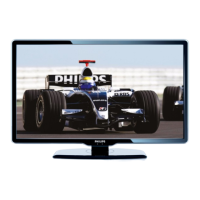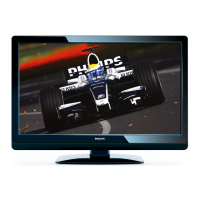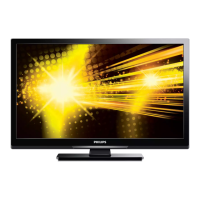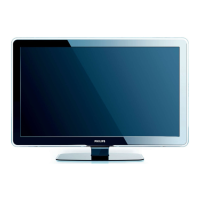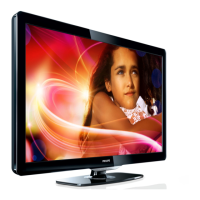Do you have a question about the Philips 32PFL7605H and is the answer not in the manual?
Consolidates safety, shock, fire, injury, and overheating warnings.
Covers power cord risks, hearing damage, and screen care.
How to access and use green eco settings via the remote control.
Highlights low standby power and dedicated power switch.
Instructions and considerations for mounting the TV on a wall.
Explanation of Ambilight for enhanced viewing experience.
Information on digital broadcasts and the Electronic Programme Guide.
Identification and functions of the remote control buttons.
How to launch activities and access TV features via the home menu.
Instructions for switching the TV on/off and to standby mode.
Using presets like Vivid, Natural, Cinema for picture quality.
Using presets like Personal, Standard, Movie for sound quality.
Changing aspect ratios like Auto fill, Auto zoom, and Wide screen.
Switching Ambilight on/off and setting active modes.
Requirements and steps for setting up and registering for Net TV.
Overview, switching on, and options for the EPG.
Selecting pages and accessing teletext options.
Setting codes, locking channels, and age ratings for content control.
Renting videos via Net TV and inserting an SD card.
Connecting USB storage and playing files.
Setting single pictures or slideshows as TV wallpaper.
Enabling special audio and subtitles for users with impairments.
Using smart picture settings and advanced picture options.
Reordering and renaming channels for user preference.
Step-by-step guide for manual channel search and storage.
PC network and Net TV advantages with internet connection.
Connecting the TV to a router using an Ethernet cable.
Enabling media sharing and selecting folders for TVersity/Twonky.
Configuring energy-saving modes and audio delay.
Updating software via Internet, USB, or digital broadcast.
Resetting all settings and reinstalling TV channels.
Properly connecting the power cord and antenna cable.
Using HDMI for HD quality and Y Pb Pr with audio.
Connecting devices via SCART for standard video signals.
Details of network, SCART, component, HDMI, and audio out ports.
Locating HDMI, USB, SD card, and Common Interface slots.
Step-by-step guide to connect a Blu-ray player via HDMI.
How to connect a DVD player using an HDMI cable.
Connecting antenna and SCART cables for a DVD recorder.
Connecting HTS via HDMI or digital/analogue audio out.
Connecting antenna and SCART cables for digital receivers.
Connecting multiple devices like receivers, recorders, and HTS.
Connecting consoles and enabling game mode for reduced latency.
Connecting a digital camera via USB for viewing pictures.
Using different cables for PC connection to the TV.
Connecting a computer using a VGA cable.
How to turn Philips EasyLink functionality on or off.
Using EasyLink for simplified device operation.
Managing audio output through connected Home Theatre Systems.
Using the TV remote to control HDMI-CEC devices.
Adjusting picture processing and subtitle display via EasyLink.
Playing audio from connected devices while TV is in standby.
Accessing the On-Screen Remote Control for device functions.
Step-by-step guide for inserting and activating the CAM.
Troubleshooting power, remote control, and standby light problems.
Resolving issues with missing channels and distorted pictures.
Resolving sound problems and HDMI connection errors.
Addressing issues with USB content display and PC connection stability.
Details on power consumption, reception standards, and display type.
Information on sound output, display resolutions, and multimedia connections.
Details on supported multimedia file types and DLNA server software.
Overview of all TV ports and physical dimensions of the unit.
| Response time | 2 ms |
|---|---|
| Display diagonal | 32 \ |
| Display brightness | 450 cd/m² |
| Native aspect ratio | 16:9 |
| LED backlighting type | Edge-LED |
| Supported video modes | 1080p |
| Viewing angle, vertical | 176 ° |
| Contrast ratio (dynamic) | 500000:1 |
| Display diagonal (metric) | 81.2 cm |
| Supported graphics resolutions | 1920 x 1080 (HD 1080) |
| 3D | No |
| HDMI | Yes |
| Set width | 777 mm |
| Audio formats supported | AAC, MP3, WMA |
| Image formats supported | JPG |
| Video formats supported | AVI, H.264, MKV, MPEG1, MPEG2, MPEG4, VC-1, WMV9 |
| HDMI version | 1.4 |
| Audio (L/R) in | 3 |
| HDMI ports quantity | 4 |
| DVI-D ports quantity | - |
| SCART ports quantity | 2 |
| USB 2.0 ports quantity | 1 |
| Compatible memory cards | SD, SDHC |
| S-Video inputs quantity | 0 |
| Audio system | Mono, Nicam Stereo, Stereo |
| RMS rated power | 20 W |
| Tuner type | Analog & digital |
| Supported TV bands | Hyperband, S Band, UHF, VHF |
| Analog signal format system | NTSC, PAL, SECAM |
| Digital signal format system | DVB-C, DVB-T |
| AC input voltage | 220 - 240 V |
| AC input frequency | 50 - 60 Hz |
| Power consumption (standby) | 0.15 W |
| Power consumption (typical) | 71 W |
| Power consumption (PowerSave) | 0 W |
| Product color | Gray |
| Panel mounting interface | 300 x 200 mm |
| Package depth | 158 mm |
| Package width | 950 mm |
| Package height | 572 mm |
| Package weight | 13000 g |
| Operating temperature (T-T) | 5 - 40 °C |
| Depth (with stand) | 221 mm |
|---|---|
| Height (with stand) | 540 mm |
| Weight (with stand) | 11600 g |
| Depth (without stand) | 42 mm |
| Height (without stand) | 472 mm |
| Weight (without stand) | 9500 g |
